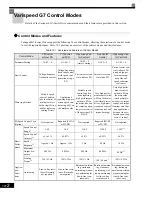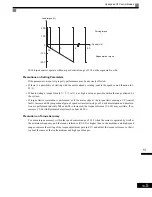
10
-4
Application Function Precautions
Observe the following precautions when using the application functions.
•
Perform rotational autotuning during trial operation whenever it is possible to separate the motor and
machine. To achieve the characteristics of vector control described in
, the control must be
adjusted within a range that the machine will not vibrate after rotational autotuning has been performed.
•
With vector control, the motor and Drive must be connected 1:1. Vector control is not possible when mul-
tiple motors are connected to a single Drive. Select Drive capacity so the rated motor current is 50% to
100% of the rated Drive current.
•
For estimated speed searching, the motor and Drive must be connected 1:1. The speed search must be per-
formed at a frequency of 130 Hz or less and with a motor with the same number of frames as or one frame
less than the Drive capacity.
•
During high-slip braking, motor loss increases, so use a high-slip braking frequency of 5% ED or less, and
a braking time of 90 seconds or less. Once high-slip braking has started, the motor cannot be restarted until
it has stopped.
•
Feed forward control is a function that improves the proportional gain of the motor speed in relation to the
change in the speed reference. Adjust the response to interference loads using the speed controller (ASR)
parameters.
•
The torque limit function will not operate during acceleration or deceleration (during soft start transition)
when using a control mode such as open-loop vector control 1. Even if the motor speed drops due to torque
limiting while set to a fixed speed, the speed will not fall below the minimum frequency and the motor will
not slip into reverse rotation. These conditions also apply to open-loop vector control 2 and other applica-
tion functions.
Precautions When Using Open-loop Vector Control 2
Using open-loop vector control 2 (A1-02=4) gives a higher level of control than conventional open-loop vec-
tor control (A1-02=2). When using open-loop vector control 2, pay attention to the points listed below. For a
comparison with other control modes, refer to
Table 10.1 Overview and Features of Control Modes
.
General Precautions
•
The maximum possible setting for the maximum output frequency (E1-04) is 60 Hz.
•
Be sure to perform autotuning. Refer to the precautions given under
Autotuning
in
.
Precaution on Regeneration
With speed control, in the low speed range (approx. 6 Hz max.), the speed increases for large regenerative
loads, and it may not be possible to maintain speed accuracy. Examples are given below for forward rota-
tion at frequencies of 0.3, 1, 3, 6, and 60 Hz.
Summary of Contents for CIMR-G7U
Page 2: ......
Page 7: ...v...
Page 32: ...1 18...
Page 90: ...3 16...
Page 112: ...4 22...
Page 382: ...6 164...
Page 410: ...7 28...
Page 454: ......
Page 455: ......
















































